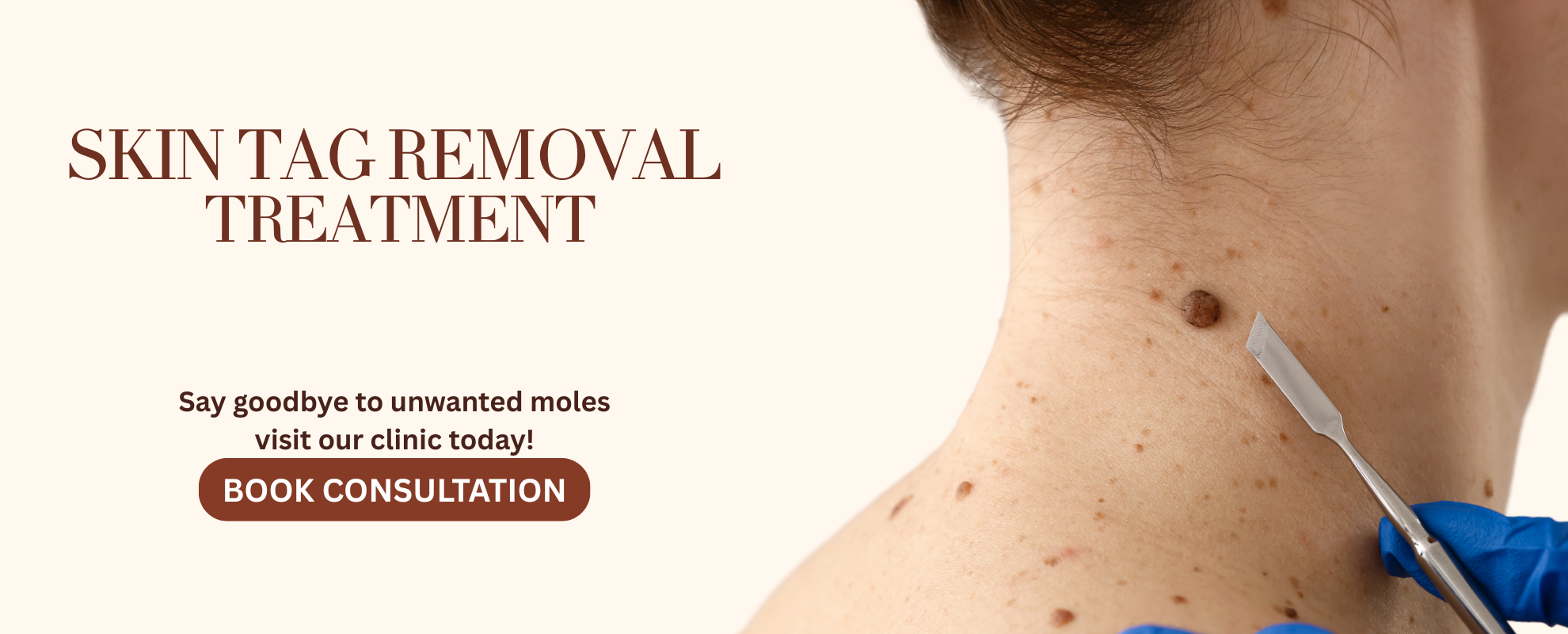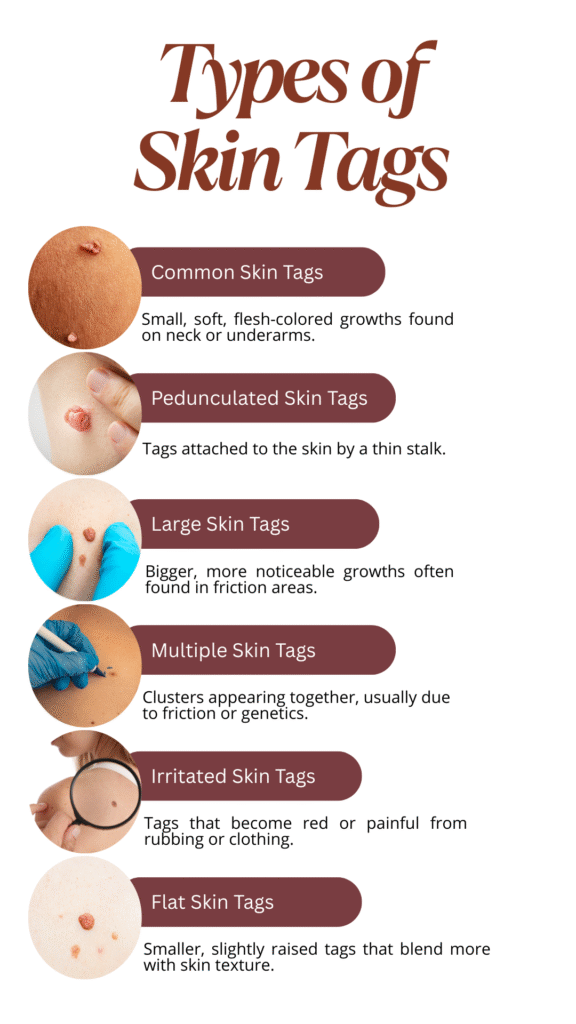
Clear, Smooth & Spot-Free Skin with Skin Tag Removal Treatment
Skin tags can make your skin look uneven and may cause discomfort when they rub against clothing or jewelry. At Urban Skin and Hair Clinic, our advanced Skin Tag Removal treatments offer a safe, precise, and minimally invasive solution to remove these small, benign growths effectively. Using modern laser and radiofrequency technology, our dermatologists target the skin tag without harming the surrounding skin, ensuring a clean and smooth finish. Whether for cosmetic enhancement or everyday comfort, each treatment is tailored to your skin needs, providing a quick, comfortable, and low-downtime experience. With expert care, advanced tools, and a personalised approach, we help you achieve clear, smooth, and spot-free skin so you can feel confident and comfortable in your own skin again.
What is Skin Tag Removal Treatment?
Skin Tag Removal Treatment is a safe, quick, and precise dermatological procedure used to remove small, soft, and benign skin growths commonly found on the neck, underarms, eyelids, groin, or under the breasts. Skin tags may be removed for cosmetic reasons, discomfort caused by friction, or on medical advice if they grow or become irritated.
At Urban Skin and Hair Clinic, skin tag removal is performed using advanced methods such as laser therapy, radiofrequency (RF) cauterization, or minor snip excision, depending on the size and location of the skin tag. The procedure is minimally invasive, virtually painless, and designed to remove the tag without damaging surrounding skin leaving your skin smoother, clearer, and more comfortable.

What Are the Types of Skin Tag?
Common Skin Tags (Acrochordons)
Small, soft, flesh-coloured growths that hang off the skin.
Common Areas: Neck, underarms, eyelids, groin.
Filiform Skin Tags
Long, thin, thread-like tags that extend outward from the skin.
Common Areas: Eyelids, neck, upper chest.
Large Skin Tags
Bigger, thicker skin tags that may grow due to friction or hormones.
Common Areas: Underarms, thighs, groin.
Multiple Skin Tags (Clustered)
Groups of small skin tags appearing together in one area.
Common Areas: Neck, armpits, under the breast.
Irritated / Inflamed Skin Tags
Tags that become red, painful, or swollen from friction or clothing.
Common Areas: Waistline, thighs, bra area.
Pedunculated Skin Tags
Tags with a narrow stalk connecting them to the skin surface.
Common Areas: Neck, back, armpits, groin.
Causes of Skin Tag
Skin tags form when collagen and blood vessels cluster inside a small fold of skin, often due to continuous friction. They commonly appear in areas where skin rubs together or against clothes. Hormonal changes, obesity, diabetes, genetics, and aging also increase the chances of developing skin tags. They are harmless but may grow over time.
Skin Tag Removal Treatment Procedure
Consultation & Skin Examination
The dermatologist evaluates the skin tag’s size, location, and type to decide the safest and most effective removal method.
Cleansing & Local Anaesthesia
The area is gently cleansed, and a numbing cream or local anaesthetic injection is applied to ensure a painless and comfortable procedure.
Removal Technique (Laser / RF / Snip Excision)
Laser: Vaporizes small and superficial skin tags with precision and minimal discomfort.
RF Cautery: Uses controlled radiofrequency heat to smoothly detach raised skin tags and seal the skin instantly.
Snip Excision: Ideal for larger or stalked skin tags; the dermatologist trims the growth using sterile tools for complete removal.
Wound Care & Antiseptic Application
After removal, the treated area is cleansed, an antiseptic is applied, and dressing is done if needed to promote quick healing.
Post-Treatment Instructions
You receive personalised aftercare guidelines to prevent irritation, avoid infection, and ensure smooth, scar-free recovery.

Benefits of Skin Tag Removal Treatment
Skin tag removal is a quick, safe, and effective dermatology procedure that eliminates unwanted skin tags with precision. It enhances your skin’s appearance, prevents irritation caused by friction, and offers smoother, cleaner skin with minimal discomfort and downtime. This simple treatment boosts confidence and restores a neat, refined look effortlessly.
- Quick removal with minimal discomfort.
- Improves skin appearance instantly.
- Prevents irritation from clothing friction.
- Reduces chance of accidental bleeding.
- Enhances overall skin smoothness.
- Safe procedure with no downtime.
- Boosts confidence with clear skin.
- Prevents future skin tag growth.
- Suitable for all skin types.
- Professionally done for long-lasting results.
Pre and Post Treatment Care
Pre-Treatment Care
- Avoid sun exposure on the area for at least 3–5 days before treatment.
- Skip active skincare products like retinoids, AHAs, and BHAs around the treatment site.
- Do not shave or irritate the mole area before the appointment.
- Inform your dermatologist about any medications, allergies, or previous skin treatments.
- Keep the skin clean and avoid applying makeup, creams, or oils on the mole before treatment.
Post-Treatment Care
- Keep the treated area clean and dry for the first 24 hours.
- Apply prescribed ointments regularly to support healing and prevent infection.
- Avoid scratching, rubbing, or picking the treated skin to prevent scarring.
- Protect the area from sun exposure using sunscreen once healing begins.
- Avoid swimming, steam, gym workouts, or heavy sweating for 48–72 hours.
How Treatment Cost Is Decided?
The cost of any treatment depends on several key factors that determine the type, intensity, and number of procedures required. Since every patient’s condition, goals, and expectations are different, the final pricing is customised to ensure safe, effective, and personalised care.
- Severity of the Condition
- Type of Treatment Recommended
- Number of Sessions Required
- Technology & Equipment Used
- Doctor’s Expertise & Clinic Standard
- Customisation of the Treatment Plan
- Area/Extent of Treatment
Get An Appointment
Why Urban Skin and Hair Clinic

TEAM OF CERTIFIED DERMATOLOGISTS

US-FDA APPROVED EQUIPMENTS

HIGHLY STANDARDISED PROTOCOLS

1 LAKH + HAPPY CLIENTS
FAQ for Skin Tag Removal Treatment
No, they are completely harmless but may cause cosmetic or physical discomfort.
Our advanced removal techniques are designed to leave minimal to no scarring.
Healing usually takes 5–7 days, depending on the size and location of the tag.
Once removed, skin tags do not grow back at the same spot, though new ones can form elsewhere.
No, it’s done under topical or local anesthesia and is completely comfortable.
Consult a Specialist Today
At Urban Skin and Hair Clinic, Dr. [Name] offers personalized treatment plans for skin tag removal after carefully examining your skin type and medical history. Whether it’s one skin tag or many, your treatment will be safe, effective, and comfortable.










